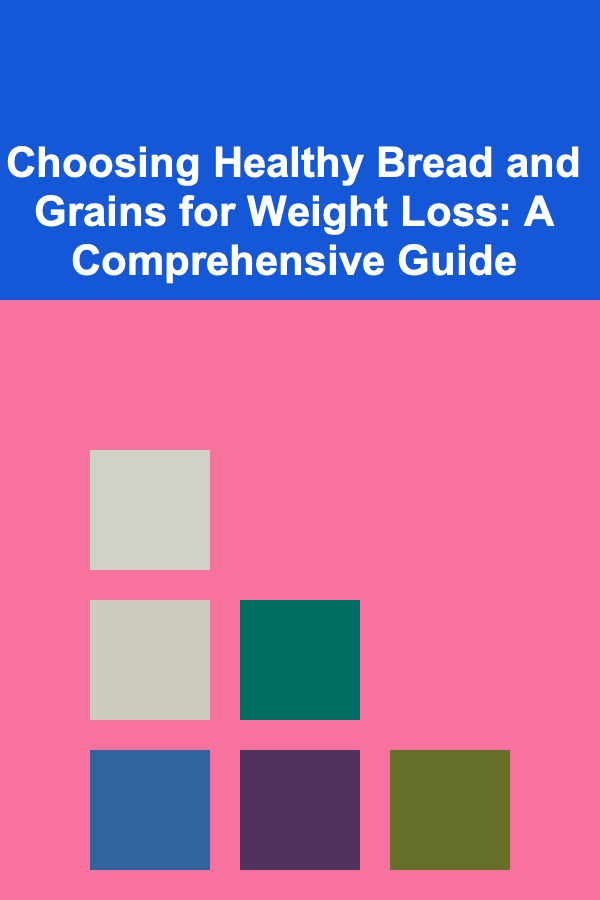
Choosing Healthy Bread and Grains for Weight Loss: A Comprehensive Guide
ebook include PDF & Audio bundle (Micro Guide)
$12.99$10.99
Limited Time Offer! Order within the next:

The journey towards weight loss is often paved with complex dietary choices, and the selection of bread and grains can be particularly confusing. While often demonized in weight loss discussions, bread and grains, when chosen wisely, can be valuable components of a balanced and effective weight management plan. The key lies in understanding the nutritional nuances of different types of bread and grains, and how they impact satiety, blood sugar levels, and overall metabolic health. This comprehensive guide aims to demystify the process of selecting healthy bread and grains, providing you with the knowledge to make informed choices that support your weight loss goals.
Understanding the Basics: Whole Grains vs. Refined Grains
The fundamental distinction in the world of grains lies between whole grains and refined grains. This difference has a significant impact on their nutritional value and their effect on your body.
Whole Grains: Nature's Nutritional Powerhouse
Whole grains contain all three parts of the grain kernel: the bran, the germ, and the endosperm. Each part contributes unique nutritional benefits:
- Bran: The outer layer of the grain, rich in fiber, antioxidants, and B vitamins. Fiber is crucial for promoting satiety, regulating blood sugar, and supporting digestive health. The antioxidants in bran help protect against cellular damage caused by free radicals.
- Germ: The nutrient-rich embryo of the grain, containing vitamins E and B, healthy fats, and phytochemicals. These nutrients are essential for energy production, cell growth, and overall well-being.
- Endosperm: The largest part of the grain, primarily composed of carbohydrates (starch) and some protein. While it provides energy, it lacks the fiber and micronutrients found in the bran and germ.
Examples of whole grains include:
- Whole wheat
- Oats (rolled or steel-cut)
- Brown rice
- Quinoa
- Barley
- Buckwheat
- Spelt
- Farro
- Millet
Refined Grains: Stripped of Nutritional Value
Refined grains have been processed to remove the bran and germ, leaving only the endosperm. This process significantly reduces the fiber, vitamins, and minerals present in the original whole grain. While refined grains have a longer shelf life and a smoother texture, they offer very little nutritional value.
Examples of refined grains include:
- White bread
- White rice
- Pasta made from refined white flour
- Corn flakes (often heavily processed)
- Pastries and cakes
The Impact on Weight Loss: Refined grains are quickly digested, leading to rapid spikes in blood sugar followed by equally rapid crashes. These blood sugar fluctuations can trigger cravings, increase hunger, and contribute to weight gain. In contrast, whole grains are digested more slowly, providing a sustained release of energy, promoting satiety, and helping to stabilize blood sugar levels, all of which are crucial for successful weight loss.
The Role of Fiber in Weight Loss
Fiber is a type of carbohydrate that the body cannot digest. This indigestibility is what makes it so beneficial for weight loss and overall health.
Benefits of Fiber for Weight Management:
- Increased Satiety: Fiber adds bulk to your meals, helping you feel fuller for longer, thus reducing overall calorie intake. It slows down the emptying of the stomach, further contributing to feelings of fullness.
- Blood Sugar Regulation: As mentioned earlier, fiber slows down the absorption of sugar into the bloodstream, preventing those drastic blood sugar spikes and crashes that lead to cravings and overeating.
- Improved Digestion: Fiber promotes regular bowel movements, preventing constipation and supporting a healthy gut microbiome. A healthy gut microbiome is increasingly recognized for its role in weight management and overall health.
- Reduced Cholesterol Levels: Some types of fiber, particularly soluble fiber, can help lower LDL (bad) cholesterol levels, reducing the risk of heart disease.
How Much Fiber Do You Need?
The recommended daily intake of fiber is around 25-30 grams. Many people fall short of this recommendation. Incorporating whole grains into your diet is an excellent way to increase your fiber intake. Pay attention to nutrition labels and choose bread and grain products that are high in fiber (at least 3 grams per serving is a good starting point).
Navigating the Bread Aisle: Decoding Labels and Avoiding Pitfalls
The bread aisle can be a minefield of misleading marketing claims. It's crucial to become a savvy label reader to avoid falling for tricks that make unhealthy bread seem healthy.
Key Terms to Understand:
- "Whole Wheat": This indicates that the bread is made with whole wheat flour, which contains all parts of the wheat kernel. However, it's important to look for "100% whole wheat" to ensure that all the flour used is whole wheat.
- "Multigrain": This simply means that the bread contains more than one type of grain. It doesn't necessarily mean that the grains are whole grains. The bread could contain a mix of refined and whole grains.
- "Wheat Bread": This term is often used to describe bread made with some wheat flour, but it may not be whole wheat flour. It can often be a mix of refined and whole wheat flour.
- "Enriched Flour": This refers to refined flour that has had some vitamins and minerals added back in after being processed. However, the fiber is not typically restored, and it doesn't provide the same nutritional benefits as whole grain flour.
- "Stone-Ground": This refers to the method of grinding the grain, not the type of grain. Stone-ground flour can be either whole grain or refined.
Tips for Choosing Healthy Bread:
- Read the Ingredient List: The first ingredient should be "100% whole wheat flour" (or another whole grain flour). Avoid breads where the first ingredient is "enriched wheat flour" or "wheat flour."
- Check the Fiber Content: Look for breads with at least 3 grams of fiber per slice. Ideally, aim for 4-5 grams or more.
- Look at the Sugar Content: Breads can often be surprisingly high in added sugar. Choose breads with minimal added sugar (less than 2 grams per slice is ideal).
- Beware of Additives: Many commercially produced breads contain additives like preservatives, artificial colors, and dough conditioners. Choose breads with a shorter ingredient list and fewer artificial ingredients.
- Consider the Sodium Content: Bread can contribute significantly to your daily sodium intake. Choose breads with lower sodium content.
- Look for the Whole Grain Stamp: The Whole Grain Council provides a Whole Grain Stamp that appears on many products. This stamp indicates the amount of whole grain per serving.
Examples of Healthier Bread Choices:
- 100% Whole Wheat Bread
- Sprouted Grain Bread (like Ezekiel bread)
- Sourdough Bread (often easier to digest)
- Rye Bread (especially pumpernickel rye)
Beyond Bread: Expanding Your Grain Options for Weight Loss
While bread is a common staple, there are many other healthy grains that can be incorporated into your diet to support weight loss.
Quinoa: The Complete Protein Powerhouse
Quinoa is a complete protein, meaning it contains all nine essential amino acids that the body cannot produce on its own. It is also a good source of fiber, iron, and magnesium. Quinoa is versatile and can be used in salads, soups, or as a side dish.
Oats: A Heart-Healthy and Filling Choice
Oats are a soluble fiber powerhouse, which can help lower cholesterol levels and promote feelings of fullness. Choose steel-cut oats or rolled oats over instant oats, as they are less processed and have a lower glycemic index.
Brown Rice: A Nutritious Alternative to White Rice
Brown rice is a whole grain that retains the bran and germ, providing more fiber and nutrients than white rice. It's a good source of manganese and selenium. Consider using brown rice in stir-fries, salads, or as a side dish.
Barley: A Versatile and Fiber-Rich Grain
Barley is a good source of both soluble and insoluble fiber. It can be used in soups, stews, or as a side dish. Pearled barley is more common, but it has been processed to remove some of the bran, so hull-less barley is a more nutritious option.
Buckwheat: A Gluten-Free Option with Many Benefits
Despite its name, buckwheat is not related to wheat and is naturally gluten-free. It is a good source of fiber, protein, and minerals. Buckwheat can be used to make pancakes, noodles (soba noodles), or kasha (roasted buckwheat groats).
Incorporating Healthy Bread and Grains into Your Weight Loss Diet
The key to successful weight loss with bread and grains is moderation and mindful consumption. Here are some tips for incorporating them into your diet in a healthy way:
- Portion Control: Be mindful of portion sizes. A serving of bread is typically one slice, and a serving of cooked grains is about 1/2 cup.
- Combine with Protein and Healthy Fats: Pairing bread and grains with protein and healthy fats can help slow down digestion and prevent blood sugar spikes. For example, have whole wheat toast with avocado and an egg, or brown rice with grilled chicken and vegetables.
- Choose Whole Grain Versions: Always opt for whole grain versions of bread, pasta, rice, and other grains.
- Read Labels Carefully: As discussed earlier, become a savvy label reader to make informed choices.
- Listen to Your Body: Pay attention to how different types of bread and grains make you feel. Some people may be more sensitive to certain grains than others.
- Experiment with Different Grains: Don't be afraid to try different types of whole grains to find ones that you enjoy. Variety is key to maintaining a healthy and balanced diet.
- Consider Sprouted Grains: Sprouted grains are easier to digest and may have a lower glycemic index.
- Be Aware of Hidden Calories: Toppings and spreads can add significant calories to your bread and grain dishes. Choose healthy toppings like avocado, hummus, or nut butter in moderation. Avoid sugary jams, jellies, and high-fat spreads.
The Glycemic Index and Glycemic Load: Understanding Their Impact
The Glycemic Index (GI) and Glycemic Load (GL) are tools that can help you understand how different foods affect your blood sugar levels. While they are not the only factors to consider, they can be useful in making informed choices, particularly for people with diabetes or insulin resistance.
Glycemic Index (GI):
The GI measures how quickly a food raises blood glucose levels compared to pure glucose (which has a GI of 100). Foods with a high GI are digested quickly and cause a rapid spike in blood sugar, while foods with a low GI are digested more slowly and cause a more gradual rise in blood sugar.
- High GI (70 or more): White bread, white rice, corn flakes
- Medium GI (56-69): Whole wheat bread, brown rice
- Low GI (55 or less): Oats, quinoa, barley
Glycemic Load (GL):
The GL takes into account both the GI of a food and the amount of carbohydrates it contains in a typical serving. It provides a more accurate picture of how a food will affect blood sugar levels than the GI alone.
- High GL (20 or more): White bread, large serving of white rice
- Medium GL (11-19): Whole wheat bread, brown rice
- Low GL (10 or less): Oats, quinoa, barley
How to Use GI and GL for Weight Loss: Choosing foods with a lower GI and GL can help stabilize blood sugar levels, promote satiety, and reduce cravings, which can be beneficial for weight loss. However, it's important to remember that GI and GL are not the only factors to consider. You should also focus on eating whole, unprocessed foods and maintaining a balanced diet.
Debunking Common Myths About Bread and Grains
There are many misconceptions surrounding bread and grains, particularly in the context of weight loss. Let's address some of the most common myths:
- Myth: All bread is bad for you. Reality: Whole grain bread can be a healthy part of a balanced diet. The key is to choose the right type of bread.
- Myth: You have to cut out all carbs to lose weight. Reality: Carbohydrates are an essential macronutrient that provide energy for the body. Cutting out all carbs is not sustainable or healthy for most people. The focus should be on choosing complex carbohydrates (like whole grains) over simple carbohydrates (like refined sugar).
- Myth: Gluten is inherently unhealthy. Reality: Gluten is only a problem for people with celiac disease or gluten sensitivity. For most people, gluten is not harmful.
- Myth: "Wheat" bread is always healthy. Reality: As discussed earlier, "wheat" bread is not necessarily whole wheat bread. Always read the ingredient list to ensure that the bread is made with 100% whole wheat flour.
Conclusion: Making Informed Choices for a Healthier You
Choosing healthy bread and grains for weight loss doesn't have to be a daunting task. By understanding the difference between whole grains and refined grains, paying attention to nutrition labels, and incorporating a variety of healthy grains into your diet, you can make informed choices that support your weight loss goals and overall health. Remember that moderation, mindful eating, and a balanced diet are key to success. Don't be afraid to experiment and find healthy bread and grain options that you enjoy and that fit into your lifestyle. With the right knowledge and approach, you can enjoy bread and grains as part of a healthy and sustainable weight loss plan.

How to Save Money with Easy and Effective DIY Beauty Treatments
Read More
How to Sell Homemade Skincare Products on Etsy: An Actionable Guide
Read More
How to Stage Your Home for a Quick Sale on a Budget
Read More
Making Money with AI: How to Profit from Deep Learning
Read More
How To Use Feedback for Continuous Improvement
Read More
10 Tips for Incorporating Beads into Your Weaving
Read MoreOther Products

How to Save Money with Easy and Effective DIY Beauty Treatments
Read More
How to Sell Homemade Skincare Products on Etsy: An Actionable Guide
Read More
How to Stage Your Home for a Quick Sale on a Budget
Read More
Making Money with AI: How to Profit from Deep Learning
Read More
How To Use Feedback for Continuous Improvement
Read More